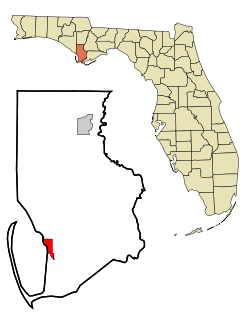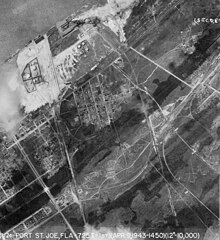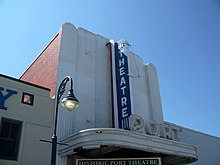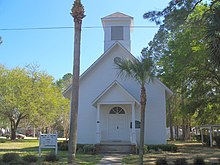Port St. Joe, Florida
Port St. Joe, Florida | |
|---|---|
| City of Port St. Joe | |
 Port St. Joe City Hall | |
| Nickname: St. Joe | |
| Motto(s): "The Constitution City" "Birthplace of the Florida Constitution" "In God We Trust" | |
 Location in Gulf County and the state of Florida | |
| Coordinates: 29°48′53″N 85°17′50″W / 29.81472°N 85.29722°W | |
| Country | |
| State | |
| County | Gulf |
| Settled | 1835-1862 |
| Incorporated | 1913[1] |
| Named for | St. Joseph Bay |
| Government | |
| • Type | Commission–Manager |
| • Mayor | Rex Buzzett |
| • Commissioners | Scott Hoffman, Brett Lowry, Steve Kerigan, and Eric Langston |
| • City Manager | Jim Anderson |
| • City Clerk | Charlotte Pierce |
| Area | |
| • Total | 11.97 sq mi (30.99 km2) |
| • Land | 9.37 sq mi (24.26 km2) |
| • Water | 2.60 sq mi (6.73 km2) |
| Elevation | 2 ft (0.6 m) |
| Population (2020) | |
| • Total | 3,357 |
| • Density | 358.39/sq mi (138.38/km2) |
| Time zone | UTC−5 (Eastern (EST)) |
| • Summer (DST) | UTC−4 (EDT) |
| ZIP codes | 32456, 32457 |
| Area code | 850 |
| FIPS code | 12-58675 |
| GNIS feature ID | 2404557[3] |
| Website | www |
Port St. Joe is a city and the county seat of Gulf County, Florida. It is located at the intersection of U.S. Highway 98 and State Road 71. As of the 2020 census, the population was 3,357.
History
[edit]
St. Joseph was founded in 1835 by businessmen from nearby Apalachicola, which was troubled by legal conflict over land titles.[4] It was mostly abandoned in 1841, after a yellow fever epidemic; a storm surge produced by a hurricane in 1844 destroyed what structures remained.[5]
During the Civil War, Florida was a leading producer of salt for the Confederate army. On September 15, 1862, a Union army officer on board the USS Kingfisher wrote that he and his men had sent a demand to the extensive salt works at Saint Joseph that they cease production. When the work was not halted, the Kingfisher went into Saint Joseph bay, sent at least 50 men inland, and destroyed the salt works.[6]
In the early 20th century, a new settlement was founded close to the original after the arrival of the Apalachicola Northern Railroad in 1909. It appears that the more informal "Port St. Joe" was adopted for official use around this time.
The community was extensively damaged by Hurricane Michael on October 10, 2018.[7]
Geography
[edit]
Port St. Joe is located in southern Gulf County at 29°48′29″N 85°17′52″W / 29.80806°N 85.29778°W (29.807968, –85.297684),[8] within the Florida Panhandle and along the Emerald Coast. According to the United States Census Bureau, the city has a total area of 12.1 square miles (31.3 km2), of which 9.5 square miles (24.5 km2) is land and 2.6 square miles (6.8 km2), or 21.86%, is water. The city limits extend into St. Joseph Bay, an arm of the Gulf of Mexico.
U.S. Route 98 passes through Port St. Joe as Monument Drive in the north and Constitution Drive in the south. US 98 leads northwest along the Gulf shore 36 miles (58 km) to Panama City and southeast 23 miles (37 km) to Apalachicola. Florida State Road 71 (Cecil G. Costin Sr. Boulevard) leads northeast 24 miles (39 km) to Wewahitchka.
Port St. Joe averages only 3 feet (0.91 m) above sea level. At its highest point it is only 8 feet (2.4 m) above sea level. This portion of the town has been dubbed "Highland View".
Climate
[edit]The City of Port St. Joe is part of the humid subtropical climate zone with a Köppen Climate Classification of "Cfa" (C = mild temperate, f = fully humid, and a = hot summer).
Demographics
[edit]| Census | Pop. | Note | %± |
|---|---|---|---|
| 1930 | 851 | — | |
| 1940 | 2,393 | 181.2% | |
| 1950 | 2,752 | 15.0% | |
| 1960 | 4,217 | 53.2% | |
| 1970 | 4,401 | 4.4% | |
| 1980 | 4,027 | −8.5% | |
| 1990 | 4,044 | 0.4% | |
| 2000 | 3,644 | −9.9% | |
| 2010 | 3,445 | −5.5% | |
| 2020 | 3,357 | −2.6% | |
| U.S. Decennial Census[9] | |||
2010 and 2020 census
[edit]| Race | Pop 2010[10] | Pop 2020[11] | % 2010 | % 2020 |
|---|---|---|---|---|
| White (NH) | 2,408 | 2,210 | 69.90% | 65.83% |
| Black or African American (NH) | 879 | 781 | 25.52% | 23.26% |
| Native American or Alaska Native (NH) | 10 | 14 | 0.29% | 0.42% |
| Asian (NH) | 12 | 25 | 0.35% | 0.74% |
| Pacific Islander or Native Hawaiian (NH) | 1 | 0 | 0.03% | 0.00% |
| Some other race (NH) | 1 | 11 | 0.03% | 0.33% |
| Two or more races/Multiracial (NH) | 44 | 145 | 1.28% | 4.32% |
| Hispanic or Latino (any race) | 90 | 171 | 2.61% | 5.09% |
| Total | 3,445 | 3,357 |
As of the 2020 United States census, there were 3,357 people, 1,494 households, and 999 families residing in the city.[12]
As of the 2010 United States census, there were 3,445 people, 1,544 households, and 946 families residing in the city.[13]
2000 census
[edit]As of the census[14] of 2000, there were 3,644 people, 1,402 households, and 1,030 families residing in the city. The population density was 1,097.4 inhabitants per square mile (423.7/km2). There were 1,571 housing units at an average density of 473.1 per square mile (182.7/km2). The racial makeup of the city was 68.52% White, 30.10% African American, 0.22% Native American, 0.22% Asian, 0.05% from other races, and 0.88% from two or more races. Hispanic or Latino of any race were 0.55% of the population.
In 2000, there were 1,402 households, out of which 28.8% had children under the age of 18 living with them, 54.2% were married couples living together, 14.8% had a female householder with no husband present, and 26.5% were non-families. 24.9% of all households were made up of individuals, and 14.0% had someone living alone who was 65 years of age or older. The average household size was 2.48 and the average family size was 2.94.
In 2000, in the city, the population was spread out, with 23.6% under the age of 18, 6.7% from 18 to 24, 24.6% from 25 to 44, 23.6% from 45 to 64, and 21.5% who were 65 years of age or older. The median age was 42 years. For every 100 females, there were 88.4 males. For every 100 females age 18 and over, there were 80.7 males.
In 2000, the median income for a household in the city was $33,800, and the median income for a family was $39,489. Males had a median income of $30,244 versus $21,111 for females. The per capita income for the city was $16,205. About 11.2% of families and 13.0% of the population were below the poverty line, including 16.2% of those under age 18 and 11.7% of those age 65 or over.
Schools and libraries
[edit]Port St. Joe, within Gulf District Schools, has one elementary school, with Dolphins as mascot. It has a joint middle-high school, Port St. Joe High School, with Sharks as the mascot. The school colors are purple and gold. There is also a small private school, Faith Christian School, which has the lions as its mascot. All of the public schools are located on one development strip set aside under the Department of Education. This begins with the elementary school and its playground and continues with the football stadium, a quarter mile running track, and finally the high school and adult school stretching a distance of about 5 city blocks. Port St. Joe also has a community college that offers two year associate degrees.
Port St. Joe has a library co-located with the senior citizens center, sheriff's office, courthouse, and animal shelter off State Road 71.
The Florida Constitutional Convention of 1838 took place in the former town of St. Joseph, the site of which is now part of Port St. Joe. There is a museum and monument commemorating this event.
Local media
[edit]
Radio
[edit]- WEBZ 99.3 FM (Urban)
- W216BT 91.1 FM (repeater of WFSW-FM, Panama City)
- WDBW-LP, 97.3 FM (Long Avenue Baptist Church, repeater of Bible Broadcasting Network)
- WOYS 106.5 FM Classic Rock/Blues/Beach Music
- WFCX 100.5 FM Tropical Rock
Newspaper
[edit]Transportation
[edit]Port St. Joe is served by a variety of transportation modes.
Water
[edit]
Port St. Joe is traversed by the Gulf Intracoastal Waterway (GIWW), a federally maintained canal with a channel of 12 feet (3.7 m) deep by 125 feet (38 m) wide, which provides access from St. Marks, Florida, to Brownsville, Texas. From the GIWW, barges can be moved inland on various river systems including the Mississippi River, Tombigbee River Waterway System, and the Apalachicola River. The Apalachicola River is Gulf County's eastern boundary.
The Port of Port St. Joe shipping channel is congressionally authorized to a depth of 35 feet (11 m) and connects to the shipping lanes of the Gulf of Mexico and to the world. Existing facilities include a manufacturer of chemical lime from dolomite, a chemical plant, a 9 million ton/year dry bulk barge-to-rail transloading terminal, and a builder of dive-cruise ships.
Rail
[edit]The AN Railway previously served the industries and port of Port St. Joe and had a history of transporting a variety of products including wood chips and other forest products, chemicals, and coal. In light of the latter, most of its 96-mile (154 km) mainline consisted of heavy duty, 140-pound (64 kg) rail on concrete ties. The AN connected with the Class I CSX Transportation at Chattahoochee, Florida. There is currently no rail service in Port St. Joe.[citation needed]
Highway
[edit]Gulf County's highway transportation needs are met with three main corridors: U.S. Route 98 along the coast and through Port St. Joe providing a route west to Panama City and east to Apalachicola, State Road 22 westward from Wewahitchka to Panama City, and State Road 71 from Port St. Joe northward toward Alabama and Georgia. Further, State Road 71 provides a low-traffic connection to Interstate 10, with only two traffic signals between Port St. Joe and Interstate 10 over the 72-mile (116 km) distance.
Notable people
[edit]- Greg Lewis, retired NFL running back
- Calvin Pryor former NFL strong safety
- Roman Quinn, MLB player
- Jason Shoaf, member of the Florida House of Representatives
- Clifford Chester Sims, United States Army soldier and Medal of Honor recipient
| Part of the series on |
| Florida Ports |
|---|
 |
| Ports |
| WikiProject Florida |
See also
[edit]- Centennial Building
- Constitution Convention Museum State Park
- Port Theatre Art and Culture Center
- St. Joseph, Gulf County, Florida
- St. Joseph Catholic Mission Church
References
[edit]- ^ "FLORIDA CITIES BY INCORPORATION YEAR" (PDF). Florida League of Cities. Retrieved January 1, 2024.
- ^ "2020 U.S. Gazetteer Files". United States Census Bureau. Retrieved October 31, 2021.
- ^ "US Board on Geographic Names". United States Geological Survey. October 25, 2007. Retrieved January 31, 2008.
- ^ Cox, Dale. "St. Joseph - Florida's Lost City - The Story of the City on St. Joseph Bay". Explore Southern History. Archived from the original on July 4, 2008.
- ^ Jones, Herman (September 8, 2016). "Death's Angel: The 'Great Tide' of 1844". The (Port St. Joe) Star. Archived from the original on October 13, 2018. Retrieved October 12, 2018.
- ^ "Destruction of a Rebel Salt Factory, on the Florida Coast". Florida Memory.
- ^ Banerjee, Neela (November 25, 2019). "The Common Language of Loss". InsideClimate News. Retrieved December 8, 2019.
- ^ "US Gazetteer files: 2010, 2000, and 1990". United States Census Bureau. February 12, 2011. Retrieved April 23, 2011.
- ^ "Census of Population and Housing". Census.gov. Retrieved June 4, 2015.
- ^ "P2 HISPANIC OR LATINO, AND NOT HISPANIC OR LATINO BY RACE - 2010: DEC Redistricting Data (PL 94-171) - Port St. Joe city, Florida". United States Census Bureau.
- ^ "P2 HISPANIC OR LATINO, AND NOT HISPANIC OR LATINO BY RACE - 2020: DEC Redistricting Data (PL 94-171) - Port St. Joe city, Florida". United States Census Bureau.
- ^ "S1101 HOUSEHOLDS AND FAMILIES - 2020: Port St. Joe city, Florida". United States Census Bureau.
- ^ "S1101 HOUSEHOLDS AND FAMILIES - 2010: Port St. Joe city, Florida". United States Census Bureau.
- ^ "U.S. Census website". United States Census Bureau. Retrieved January 31, 2008.
External links
[edit]- City of Port St. Joe official website
- Gulf County Tourist Development Council
- Gulf County Chamber of Commerce
- The Star, newspaper that serves Port St. Joe; available in full-text with images in Florida Digital Newspaper Library

